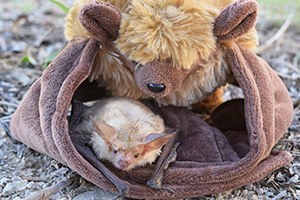Animal Fact Sheet: Great Horned Owl |
Identifying Features The great horned owl (Bubo virginianus) is the largest owl in the Sonoran Desert reaching a height of 2 feet. It is gray/brown in color with a barred feather pattern on its underside, a white throat resembling a collar, and prominent ear tufts. They have large yellow eyes with black pupils, surrounded by a facial disc of feathers that can appear slightly orangish in color. |
 |
Adaptations Great horned owls will usually perch or roost during the day in a protected area such as a tree limb or rocky overhang. When awake and hunting they use their excellent ability to hear to catch their prey. This is aided by excellent eyesight and the fact that they make little-to-no noise when they fly. |
Habitat This owl is found in every type of habitat in the Sonoran Desert region. |
Range They can be found throughout the United States, parts of Canada, and into Central and South America. The owls living in the northern portions of their range will move south as the weather turns cold. |
Wild Status They are considered to be widespread and are not currently threatened or endangered. |
Diet Great horned owls eat a variety of different foods. Some of these include birds, snakes, frogs, fish, skunks, rodents, rabbits, and hares. |
Predators Their only natural enemies are other great horned owls. Peregrine falcons have been observed attacking these owls on occasion. Their true threat comes from humans via shootings, road kill, electrocutions and traps. |
Home Great horned owls nest during January and February. Their nesting site is varies from a stick nest on a ledge, in an abandoned building, to the top of a saguaro cactus. |
Life Span In the wild their life span is 12-15 years. In a zoological setting, they may live to be as old as their late 20's. |
Size These owls can weigh as much as 2 to 3 pounds and stand 2 feet tall. |
Extra Fun-facts
|
 ©Copyright 2008, Arizona-Sonora Desert Museum
©Copyright 2008, Arizona-Sonora Desert Museum










